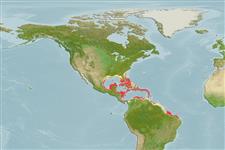>
Eupercaria/misc (Various families in series Eupercaria) >
Labridae (Wrasses) > Corinae
Etymology: Halichoeres: Greek, als, alis = salt + Greek, choiros = pig (Ref. 45335).
More on author: Valenciennes.
Environment: milieu / climate zone / depth range / distribution range
Ecologia
marinhas associadas(os) a recifes; intervalo de profundidade 2 - 80 m (Ref. 9710), usually 4 - 60 m (Ref. 27115). Tropical; 23°C - 27°C (Ref. 27115); 35°N - 7°S, 99°W - 36°W
Western Atlantic: Bermuda and southern Florida, USA to southeastern Brazil.
Tamanho / Peso / Idade
Maturity: Lm ? range ? - ? cm
Max length : 19.3 cm TL macho/indeterminado; (Ref. 9626)
Espinhos dorsais (total) : 9; Raios dorsais (total) : 11; Espinhos anais: 3; Raios anais : 12. Juveniles yellow with silvery blue stripe along side. Super males (terminal males), have black vertical bar behind tip of pectoral fin, merging with broad black area on upper side, continuing to top of caudal peduncle and upper caudal fin. One of the easiest wrasses to identify at all its stages (Ref. 26938).
Commonly found on shallow and deep reefs and exposed rocky ledges. Feeds on various invertebrates. Forms leks during breeding (Ref. 55367). A protogynous hermaphrodite (Ref. 55367). Constantly on the move but easily attracted by divers. Generally of no interest to fisheries because of its small average size (Ref. 5217).
Ciclo de vida ou comportamento de acasalamento
Maturities | Reprodução | Spawnings | Egg(s) | Fecundities | Larvas
Distinct pairing during breeding (Ref. 205). Monandric species (Ref. 55367). Length at sex change = 7.3 cm TL (Ref. 55367).
Robins, C.R. and G.C. Ray, 1986. A field guide to Atlantic coast fishes of North America. Houghton Mifflin Company, Boston, U.S.A. 354 p. (Ref. 7251)
Status na Lista Vermelha da UICN (Ref. 130435)
Ameaça para os humanos
Harmless
Uso pelos humanos
Pescarias: espécies comerciais; Aquário: Espécies comerciais
Ferramentas
Relatórios especiais
Baixar XML
Fontes da internet
Estimates based on models
Preferred temperature (Ref.
123201): 24.2 - 28, mean 27 °C (based on 394 cells).
Índice de diversidade filogenética (Ref.
82804): PD
50 = 0.5000 [Uniqueness, from 0.5 = low to 2.0 = high].
Bayesian length-weight: a=0.00977 (0.00574 - 0.01664), b=3.15 (3.00 - 3.30), in cm total length, based on LWR estimates for this species & Genus-body shape (Ref.
93245).
Nível Trófico (Ref.
69278): 3.7 ±0.2 se; based on diet studies.
Resiliência (Ref.
120179): médio(a), tempo mínimo de duplicação da população 1,4 - 4,4 anos (Preliminary K or Fecundity.).
Fishing Vulnerability (Ref.
59153): Low vulnerability (10 of 100).
Nutrients (Ref.
124155): Calcium = 67 [41, 115] mg/100g; Iron = 0.656 [0.387, 1.181] mg/100g; Protein = 18.5 [15.7, 20.7] %; Omega3 = 0.171 [0.112, 0.263] g/100g; Selenium = 29.4 [17.9, 50.9] μg/100g; VitaminA = 136 [42, 509] μg/100g; Zinc = 1.47 [1.02, 2.26] mg/100g (wet weight);
